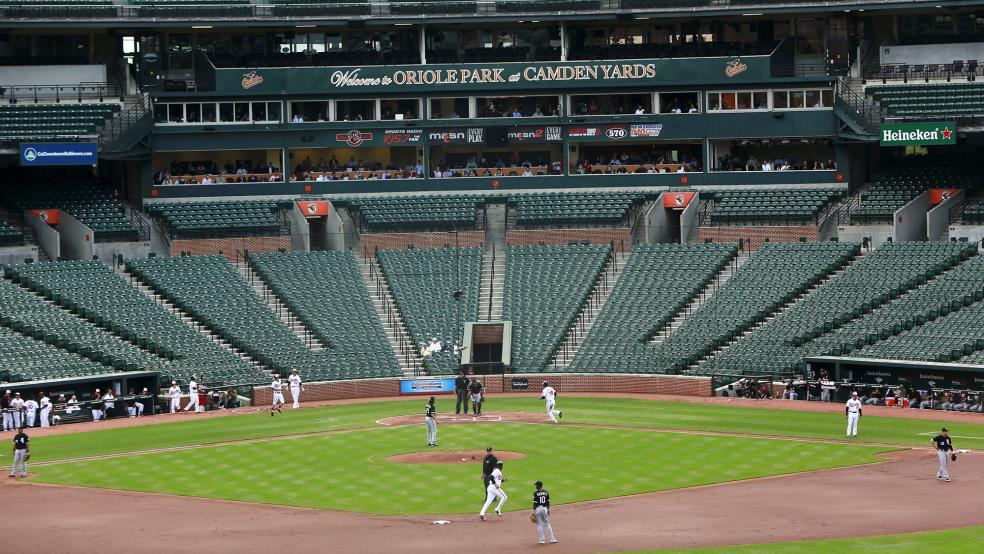As looters and arsonists roamed parts of her city on Monday afternoon, Baltimore Mayor Stephanie Rawlings-Blake bemoaned that “thugs” were senselessly destroying neighborhoods that took generations to build up. “They are tearing down businesses, tearing down or destroying property — things that we know will impact our community for years,” she added during an emotionally charged news conference.
Related: Baltimore Aftermath: The Rioters Were In Control
It will take some time before Baltimore gets a handle on the full extent of the tens of millions of dollars of damage caused by the rioting and looting that followed the funeral of a young black man, Freddie Gray, who died of spinal injuries incurred while he was in police custody. But while police, fire fighters, city officials, insurance adjusters, businessmen and others are still assessing the cost and extent of the damage, it’s safe to say that the final tally will pale in comparison with the losses suffered during many of the historic urban riots in Los Angeles, Washington, D.C., Detroit and elsewhere during the civil rights and anti-war era.
Still, if the experience of those other cities that were torn by rioting during the 1960s and 1970s is any indicator, Rawlings-Blake is painfully correct that there are likely to be serious, long-term economic consequences for Baltimore.
Cleaning up and trying to help businesses and residents hit hard by the rioting is one thing. Trying to overcome an image tarnished by searing pictures of rioting, burning cars and looted businesses, like the CVS drugstore that went up in flames, is something much different — and much harder to accomplish, according to some experts.
Related: How to Stop the Next Urban Race Riot? Ask a Republican
A Vanderbilt University study issued in December 2005 found that the riots of the 1960s and 1970s triggered white flight to the suburbs and depressed the median value of black-owned property in the inner cities, with little or no rebound. One calculation suggested about a 10 percent loss in the total value of black-owned residential property in urban areas.
A 2004 study of the impacts of the 1992 LA riots revealed $3.8 billion in lost taxable sales over 10 years, the Baltimore Business Journal reported Tuesday. Victor A. Matheson, co-author of the study, told the Business Journal he found that the adverse economic impact of riots is much greater than from hurricanes and other natural disasters, because “businesses are more likely to see natural disasters as a one-time occurrence as opposed to an ongoing safety issue.”
“It’s distressing because people I know have worked really hard to revitalize these neighborhoods and get CVS and other stores to come back and invest in these neighborhoods,” Marie Howland, Professor of Urban Studies and Planning at the University of Maryland, said in an interview today. “And this is just what everyone is afraid of – that it’s not secure.”
“They make these investments and then this happens,” she added. “Capital is really mobile. So if you could invest in your business in the suburbs or in the central city, I think people are likely to go to the suburbs, where it’s considered safer.”
For all its problems, Baltimore — or at least parts of it — experienced something of an urban renaissance over the past several decades. But the city remains “a combustible mix of poverty, crime and hopelessness uncomfortably juxtaposed against” extraordinary wealth and prosperity, as The Washington Post’s Michael A. Fletcher, a resident of Baltimore for the past 30 years, described his home town.
Related: Baltimore Mayor Criticized for Police Response to Rioting
“Charm City,” as it is called, is home to the Johns Hopkins Hospital and the University of Maryland Medical System, the Inner Harbor commercial development the headquarters of prominent companies including Under Armour, T. Rowe Price and Carefirst — but no Fortune 500 companies. Like many other big cities, Baltimore also has large concentrations of poverty, crime and drug use. In the Sandtown-Winchester neighborhood where Freddie Gray grew up, more than half of the neighborhood’s households earned less than $25,000 a year, according to a 2011 Baltimore Health Department report. And more than one in five adults were unemployed – or roughly double the citywide average.
Howland of the University of Maryland said the rioting would only add to the daunting challenge of keeping residents and businesses, or attracting new enterprise.
“I would say that for a new company who is going to start up and thinking about where to put their investment, they would think twice about putting it in a central city, in a distressed neighborhood that so desperately needs these services,” Howland said. “And the sad thing is, it’s only a few people who do this. The rest of the residents are law-abiding, appreciative and shopping there. It’s just a few.”
Top Reads From The Fiscal Times:




